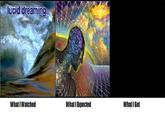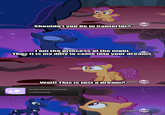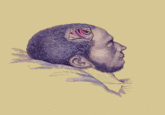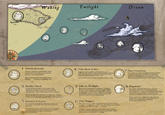
| Navigation |
| About • History • Online Presence • Highlights • KYM Mini-Guide To lucid Dreaming • Search Interest • External References • Recent Images • Recent Videos |
About
Lucid Dreaming is a sleep phenomenon that occurs when a person becomes aware that he or she is dreaming while asleep, the knowledge of which can often lead to one's total control over what happens during the rest of the dream. Online, many websites and communities have arisen where enthusiasts can discuss different techniques that may induce lucid dreaming.
History
The concept of lucid dreaming may have originated with Yoga nidra,[4] an ancient Hindu and Buddhist spiritual practice which aims to reach a lucid sleep-like state during meditation. In 1867, French sinologist Marie-Jean-Léon, Marquis d'Hervey de Saint Denys[5] conducted an extensive study of lucid dreaming as a scientific phenomenon in his book Dreams And The Ways To Direct Them: Practical Observations.
In Film
Several films have contained references to lucid dreaming, including Inception, Waking Life,Vanilla Sky and Eternal Sunshine of the Spotless Mind.
Online Presence
On March 19th, 1994, the website Lucidity[6] was launched, which provides information, articles and a mailing list for lucid dreaming-related discussions. On October 14th, 2012, the website Dreaming Lucid[13] was created, containing interviews, challenges, how-to guides and other information related to lucid dreaming. On November 17th, 2014, the website Lucidipedia[12] was launched, which refers to itself as "the world's premier lucid dreaming academy." On March 17th, 2008, the website World of Lucid Dreaming[7] was created, containing articles and videos on various lucid dreaming techniques. On July 20th, a Facebook[9] page titled "Lucid Dreams" was launched, which garnered upwards of 13,600 likes in the next six years. On June 4th, 2010, the Internet humor site Cracked[8] published an article about lucid dreaming, which noted that the practice can increase the risk of sleep paralysis, a state in which a person is temporarily unable to move upon waking that is often accompanied by auditory and visual hallucinations. As of March 2014, the article has been viewed more than 2.5 million times.
On YouTube
On December 29th, 2008, the Howcast YouTube channel uploaded a video with tips on how to lucid dream, gathering more than 2.56 million views and 12,900 comments in five-and-a-half years (shown below).
On October 23rd, 2011, YouTuber ysergiu uploaded a binaural recording meant to encourage lucid dreaming (shown below, left). In three years, the video garnered upwards of 1.16 million views and 1,500 comments. On October 10th, 2012, the AsapScience YouTube channel posted a video on the science of lucid dreaming, gathering more than 3.9 million views and 13,800 comments in the first two years (shown below, right)
On Reddit
On June 16th, 2009, the /r/LucidDreaming[11] subreddit was formed, containing discussions and links relevant to the dreaming phenomenon. In five years, the subreddit received over 107,400 subscribers. On February 20th, 2013, Redditor reediculus1 submitted an And It's Gone image macro lamenting waking up after becoming aware of being in a dream to the /r/AdviceAnimals[14] subreddit (shown below). Prior to being archived, the post received over 3,800 up votes and 150 comments. On December 10th, Redditor bigbeno98 submitted a post requesting lucid dreaming techniques to the /r/AskReddit[15] subreddit, gathering upwards of 2,700 up votes and 990 comments.

Highlights
Aurora the Dream-Enhancing Headband
In January 2014, a Kickstarter[10] campaign was created by the company iWinks for their product Aurora, a headband which produces lights and sounds meant to promote lucid dreaming in the wearer (shown below). By January 21st, the campaign was funded with more than $239,000 of its $90,000 goal.
KYM Mini-Guide To lucid Dreaming
Courtesy of Scrub
Lucid dreaming is basically being aware of your consciousness while dreaming. You know you’re in a dream and you can, with plenty of practice, fully control your dreams to your imagination’s extent, assuming you’re aware that you’re dreaming, that is.
But I don’t have dreams!
Yes, you do. You go through 3-7 dreams per night but the problem is that you don’t remember them.
How do I get Lucid Dreams?
Plenty of different ways, varying from hypnosis all the way to making a habit of doing reality checks. Some ways that I’m going to describe include a technique called Wake Induced Lucid Dreaming. And remember, practice often and you’ll increase chances of inducing lucid dreams! Also, you will lose a little bit of sleep doing this kind of stuff due to the fact that you may or may not encounter some pretty terrifying situations such as sleep paralysis and some rather zany situations like Out of Body Experiences.
Dream recalling is important, I should add, because it helps you get the grasp on what the dreams are like, help you become familiar with the wonderland that is your dreams. It’s best to keep a dream journal and to write your dreams down immediately once you wake up, cause there’s a very good chance that once you’re out of the door in your room, you’re not going to remember it that well. Describe that dream, no matter how fragmented it was. Get at least one dream down every night for a bit before starting on the techniques below or on the Internet.
Dream Induced Lucid Dreams, or D.I.L.D., are basically dreams that you figure out is a dream while in said dream. How to achieve this is through forming habits. Make constant reality checks such as looking at your hands and counting your fingers, look at the fine details engraved into your palms. Your dreams aren’t usually able to form hands and fingers and toes perfectly, and you will be able to phase your hand through your other hand, so check to see if you can put your finger through the palm of your hand as a reality check. Try looking at the clock and watch the hands move, or the numbers on the clock. In dreams, the clocks either don’t move, have different signs on them or move sporadically. That also is a good way.
One more thing, dreamsigns. Some of you might remember that episode of American Dad where Steve learned how to lucid dream via seeing a red, rubber ball bounce through, acting as a trigger to his lucidity and allowing him to indulge in his lewd fantasies. They’re basically that, they’re to help you realize you’re in a dream. Learn the elements of your dreams and find out what’s reoccurring so you can take advantage of it and use it as a dreamsign. There might be a chance that those reoccurring signs mean something though.
Another way would be Mnemonic Induction of Lucid Dreams, or MILD. The best time to do this is when you’ve just awoken from a dream in the middle of the night and before going back to sleep. What you do in this time frame is to recall as much of the previous dream you just had, as much as possible. Next is to focus on the fact that you’ll be dreaming in a short bit. You need to repeat to yourself in your head, “I’m going to be dreaming.” Or something like that like a mantra. Keep your entire focus set on that, nothing else. If anything else comes into your mind, brush it aside as quickly as possible and focus on the task ahead. Next is to place yourself back into the dream you just woke from (or a previous dream from the night before). Think this time that you’re dreaming, make sure you convince yourself. Look for dreamsigns, check your fingers, check the time, anything to help you realize you’re not awake.
Once you’ve got that down, you can go pro and do some Wake Induced Lucid Dreaming. This one can get really terrifying because of one thing: Sleep paralysis. I’ll dive into that later. What you do is basically lie in your bed as still as you can, arms by your sides, eyes closed and ignoring any form of impulse that your brain sends, such as getting an itch, turning over, moving your eyeball. Ignore all of that at, the point is to make your body fall asleep, but keep your conscious active. If you manage to stay awake for about half an hour, you’ll experience a weight on your chest and most likely will hear some voices. This is where sleep paralysis kicks in and where it can get really, really terrifying for first-timers. If you open your eyes, you will see hallucinations, vivid or faint, which will probably scare you because they could be scary looking hallucinations and you can’t move your body to hide yourself. Quickly go to sleep unless you want to be have ghosts haunting you, and you’ll have a lucid dream. If you see blackness, open your eyes, do some reality checks and you’ll be good to go.
How do I make lucid dreams last longer than when I first realize I’m dreaming?
Try not to get too excited. Too much stimulation while dreaming can cause a sensory overload and cause you to wake up. If you feel like the dream is going to break apart from how exciting it is, spin around and say “stabilize” multiple times until it feels safe again. Practice is also key, the more you get accustomed to being in lucid dreams, the less exciting the realization will be and it won’t cause you to wake up from an overload (I actually don’t know what the proper term is, so I’m using sensory overload).
My dreams are blurry/aren’t vivid!
Don’t know much about it, but if you focus on making the dream more vivid or shout stuff related to making it more vivid, it could work.
Why do this?
Plenty of reasons, although it seems to have the reputation of being able to get dream sex with anyone because you can basically do anything as long as you have the skill to. You can access your subconscious and ask it questions, you can use it to find yourself, have fun and relax, not even the sky’s the limit when it comes to lucid dreams! Although, be honest here, who’s going to use it for dream sex?
That’s about all the info I can give without going full science textbook chapter on this. Please discuss any techniques that helped you achieve lucidity, because I only explained the bare minimum of some of these and skipped others, give tips and helpful tricks, talk about any lucid dreams you can recall, this is the place to talk about it! Please, go!
Search Interest
External References
[1] Wikipedia – Lucid Dream
[2] Dreamviews – Dreamviews
[3] Dreamviews – Induction Methods & Techniques
[4] Wikipedia – Yoga Nidra
[5] Wikipedia – Marie-jean-leon
[6] Lucidity – The Lucidity Institute
[7] World of Lucid Dreaming – World of Lucid Dreaming
[8] Cracked – Lucid Dreaming
[9] Facebook – Lucid Dreams
[10] Kickstarter – Aurora – The Dream-Enhancing Headband
[11] Reddit – /r/LucidDreaming
[12] Lucidipedia – Lucidipedia
[13] Dreaming Lucid – Lucid Dreaming Experience
[14] Reddit – Been trying to lucid dream lately
[15] Reddit – To the Redditors who can lucid dream

![Anon's lucid dream -File: feelpng (11 KB, 250x250) Anonymous 12/06/17(Wed)12:36:58 No.41603253 [Reply]4160597424160329541605357 241605875 >lucid dreaming >going around and telling everyone that they're in a dream and demonstrating that their reality is inconsistent just to be a d--- >one guy starts crying >"maybe that means my sister is alive in the real world" Showing all replies >>·Anonymous 12/06/17(Wed)12:39:24 No.41 603295、>>41604678 >41603253 (0P) Don't torment dream creatures you massive a------ >> Anonymous 12/06/1 7(Wed)13:29:52 No.41 604475 :241604678 bullying your dream fairies Rude](https://i.kym-cdn.com/photos/images/list/001/321/568/8c7.png)













Comments ( 63 )
Sorry, but you must activate your account to post a comment.
Please check your email for your activation code.